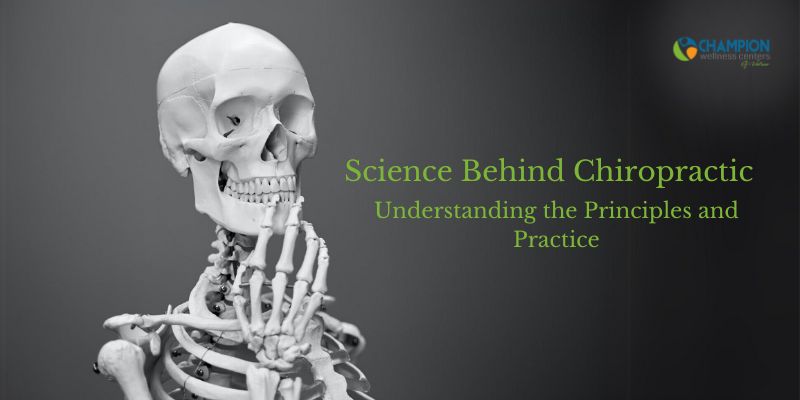Chiropractors are often associated with the treatment of back pain and spine. However, there is a broader scope of chiropractic care in healthcare. Chiropractic consists of both a scientific and artistic aspect, as it involves the restoration of the natural and holistic functioning of your body.
The Science Behind Chiropractic Care

Chiropractic care is an option for medical practice and focuses on diagnosing and treating neuromuscular issues. This approach depends on the principle that the body’s structure and its functioning are closely related, and that manual manipulation of the spine can enhance both.
Within any chiropractic care technique, chiropractic adjustments, also called chiropractic manipulations or spinal manipulation play a crucial role. These adjustments have a history dating back centuries in the treatment of diverse musculoskeletal conditions
Contemporary research about chiropractic care indicates their significant effectiveness. It is efficient in improving function, relieving pain, and promoting overall well-being.
Chiropractic Care, The Spine and The Nervous System

Chiropractors are commonly associated with the spine. This is because most of their work is centered on the nervous system. The nervous system is housed and protected within the spinal column.
From the scientific principles of chiropractic care, the optimal functioning of the nervous system is related to the overall well-being of the body. The nervous system serves as the communication network that sends and receives messages throughout the body. Any disruption in this flow can potentially result in illness or injury.
Chiropractors use specific, secure, and gentle techniques to address misalignments. It is targeted in the spine and joints which may impede effective communication within the nervous system and the rest of the body. These misalignments within the spine are referred to as subluxations, and you must correct them to eliminate any interference.
Maintaining proper posture is a significant factor that ensures a safe and healthy environment for the optimal functioning of the nervous system. When you have good posture, your nervous system can efficiently transmit messages throughout your body. By contrast, poor posture can lead to spinal misalignments and added pressure on specific areas. This often leads to dysfunction.
Chiropractors Are Healthcare Professionals
Chiropractors are healthcare professionals who can address a wide range of illnesses, injuries, and medical conditions. They are most commonly associated with the treatment of back pain. In addition to this, chiropractors are equipped to address different types of discomfort and issues related to both the musculoskeletal system and the nervous system.
Similar to neurologists or orthopedists, chiropractors make use of high-tech diagnostic imaging tools, such as CT scans and X-rays. These tools are used to fully understand your internal health and to confirm diagnoses before devising a treatment plan.
Through their extensive training and experience, chiropractors used specialized techniques to address neuromuscular disorders. Chiropractic adjustments are the most frequently used method for realigning the spine and resolving any misalignments that may contribute to health issues.
These manual adjustments tend to alleviate short-term and long-term pain by targeting the underlying causes of discomfort. When your spine is correctly aligned, your chiropractor can also engage in discussions about a holistic approach to managing your health. You may be asked to combine this care with nutrition and exercise to promote overall well-being.
Education And Training of Chiropractors
Just like professional doctors, chiropractors go through training and advanced education. It can be compared to the training accident doctors go through. The training and education students go through in chiropractic school to earn a Doctor of Chiropractic degree equips them with the knowledge and expertise to become healthcare professionals.
Chiropractic education is focused on the workings of the nervous system. The nervous system exerts control over and influences the entire body. The core philosophy and scientific principles of chiropractic care revolve around the connection between the spine and the nervous system.
Additionally, chiropractors dedicate their studies and practice to fixing misalignments and disruptions to help restore optimal bodily function. This foundation in chiropractic education is a key reason why chiropractors are often sought for the treatment of injuries resulting from car accidents.
Furthermore, chiropractors gain a comprehensive understanding of how compression, inflammation, and misalignments can impact the body’s ability to function at its best. Their training covers care for individuals of all ages, from infants to adults. This further emphasizes the critical role they play in optimizing health and well-being.
How Does Chiropractic Adjustments Improve Health?
Chiropractic adjustments have a wide range of health advantages that go far beyond the alleviation of back pain. Research has shown that many of the benefits associated with chiropractic care contribute to overall well-being.
One obvious area of impact is posture enhancement. According to some studies, chiropractic adjustments can play a significant role in improving posture. Proper posture helps to foster a more confident appearance while minimizing the risk of falls, a particularly critical benefit, especially for older adults.
Furthermore, chiropractic care can enhance digestion, reduce discomfort, and help in more efficient nutrient absorption. Chiropractic adjustments can also reduce fatigue, improve energy levels, and boost immune system function. This ultimately fortifies the body’s natural defense mechanisms.
Also, stress reduction is another advantage, as chiropractic care has been shown to help individuals manage stress more effectively. Quality sleep is pivotal for overall health, and regular chiropractic adjustments contribute to promoting better sleep quality. Improved sleep patterns leave individuals feeling more refreshed and promote their vitality.
In essence, chiropractic care serves as a holistic approach that is merely more than to relieve pain. It improves posture, physical activity, digestion, energy levels, immune function, stress management, and sleep quality. All of these benefits are vital components of comprehensive well-being.
Conclusion
The science behind chiropractic reveals a profound connection between the spine and the nervous system. This connection highlights the significance of proper alignment. Chiropractic’s principles and practice emphasize the restoration of health and function through natural means, hence, contributing to a holistic approach to well-being.



